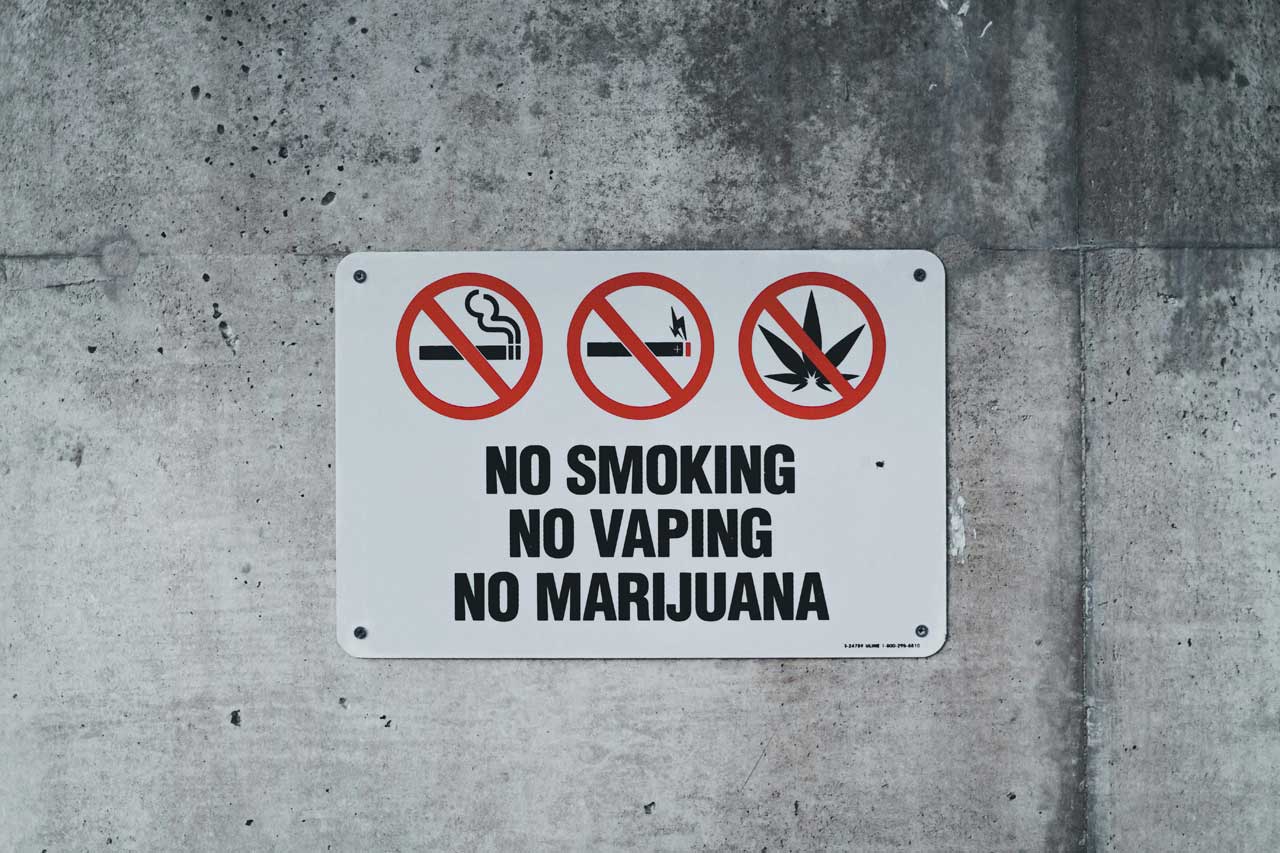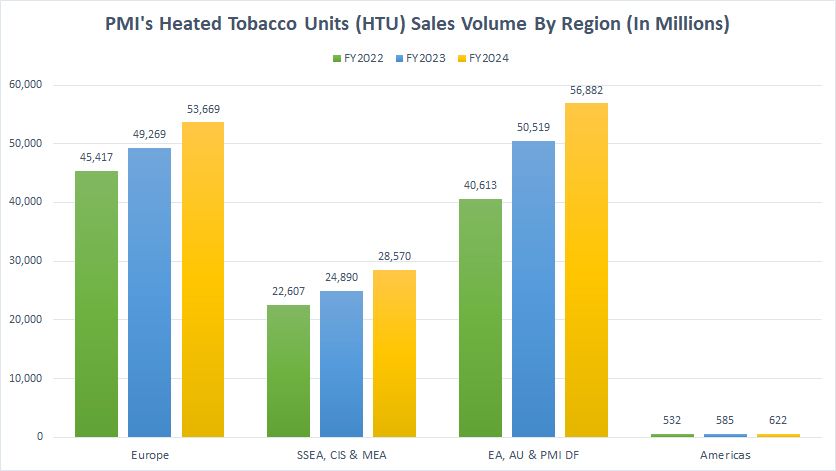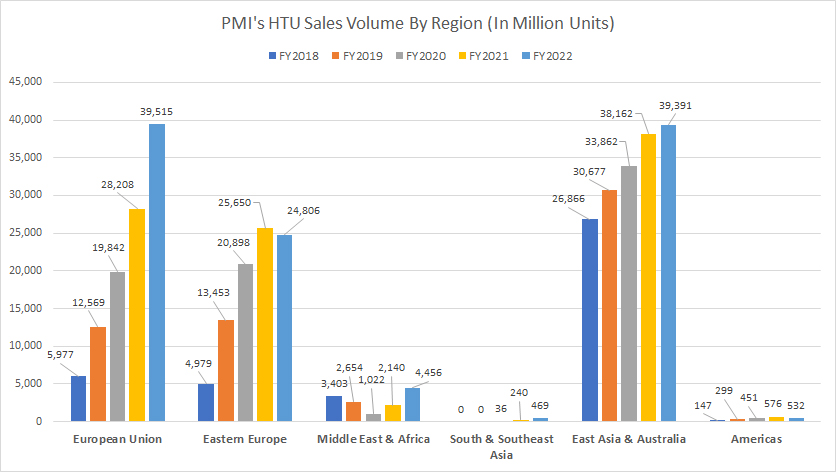
No smoking. Pexels Image.
This article presents the shipment volumes of Philip Morris International (PMI)’s heated tobacco units (HTU) in key regions.
PMI categorizes its markets into four major regions, namely: Europe, SSEA & CIS & MEA, EA & AU & PMI DF, and Americas.
Let’s check it out!
For other key statistics of Philip Morris International, you may find more resources on these pages:
Sales
- Top-selling cigarette brands,
- Global sales: cigarette and HTU combined,
- Sales by region: cigarette only,
Revenue
Market Share
- Global market share: cigarette and HTU combined,
- Market share by region: cigarette and HTU combined,
- Market share by country: cigarette and HTU combined,
- Market share by country: cigarette only,
- Market share by country: HTU only,
- Market share of Marlboro and other cigarette brands,
Profit Margin
Other Statistics
- Financial health: total debt, payment due, and cash,
- Capital expenditures,
Please use the table of contents to navigate this page.
Table Of Contents
Definitions And Overview
Sales By Region (New)
A1. HTU Sales By Region
A2. HTU Sales By Region in Percentage
Sales By Region (Legacy)
B1. HTU Sales By Region
B2. HTU Sales By Region in Percentage
Summary And Reference
S1. Insight
S2. References and Credits
S3. Disclosure
Definitions
To help readers understand the content better, the following terms and glossaries have been provided.
HTU Sales Volumes: Philip Morris International’s HTU shipment volumes are measured based on the in-market sales (IMS) volumes.
Heated Tobacco Units (HTU): HTU is the term PMI uses to refer to heated tobacco consumables, which include BLENDS, DELIA, HEETS, HEETS Creations, HEETS Dimensions (defined collectively as “HEETS”), Marlboro HeatSticks, SENTIA, TEREA, TEREA CRAFTED, and TEREA Dimensions, as well as the KT&G licensed brands, Fiit and Miix (outside of South Korea). HTU’s also include zero tobacco heat-not-burn consumables (LEVIA).
In-Market Sales (IMS): In-market sales (“IMS”) is defined as sales to the trade channels, which serve the end legal age nicotine users.
Depending on the market and distribution model, IMS may represent an estimate. Consequently, past reported periods may be updated to ensure comparability and to incorporate the most current information.
In other words, in-market sales (IMS) represents the number of units sold to consumers rather than shipments from manufacturers or distributors.
IMS is often used to gauge real consumer demand and market penetration, making it a valuable metric for assessing product performance.
Europe Region: Europe Region is headquartered in Lausanne, Switzerland, and covers all the European Union countries, Switzerland, the United Kingdom, and also Ukraine, Moldova and Southeast Europe.
SSEA, CIS & MEA: South and Southeast Asia, Commonwealth of Independent States, Middle East and Africa Region (“SSEA, CIS & MEA”) is headquartered in Dubai, United Arab Emirates.
It covers South and Southeast Asia, the African continent, the Middle East, Turkey, as well as Israel, Central Asia, Caucasus and Russia.
EA, CIS & PMI DF: East Asia, Australia, and PMI Duty Free Region (“EA, AU & PMI DF”) is headquartered in Hong Kong, and includes the consolidation of PMI’s international duty free business with East Asia & Australia.
Americas: Americas Region is headquartered in Stamford, Connecticut, and covers the United States, Canada and Latin America.
HTU Sales By Region (New)
PMI-HTU-sales-by-region-new
(click image to expand)
The definition of how PMI measures its HTU shipment volumes is available here: HTU sales volumes.
You may find more information about PMI’s regions here: Europe, SSEA, CIS & MEA, EA, AU & PMI DF, and Americas.
PMI reorganized its regions from the previous six to four starting in fiscal year 2023. Prior year data was a recast. Legacy regions are presented here: legacy regions.
Philip Morris International (PMI) distributes its HTU products primarily in Europe and the EA, AU & PMI DF regions. The Americas region makes up only a very small portion of PMI’s HTU global volume.
The following table shows a detailed breakdown:
HTU Sales Volumes in FY2024:
| Region | Sales (in billion units) |
|---|---|
| Europe | 53.7 |
| SSEA, CIS & MEA | 28.6 |
| EA, AU and PMI DF | 56.9 |
| Americas | 0.6 |
| Total Region | 139.7 |
2-Year Sales Trend from FY2022 to FY2024:
| Region | Sales (in billion units) | % Changes |
|---|---|---|
| Europe | 45.4 – 53.7 | +18.2% |
| SSEA, CIS & MEA | 22.6 – 28.6 | +26.4% |
| EA, AU and PMI DF | 40.6 – 56.9 | +40.1% |
| Americas | 0.5 – 0.6 | +16.9% |
| Total Region | 109.2 – 139.7 | +28.0% |
HTU Sales By Region In Percentage (New)
PMI-HTU-sales-by-region-new-in-percentage
(click image to expand)
The definition of how PMI measures its HTU shipment volumes is available here: HTU sales volumes.
You may find more information about PMI’s regions here: Europe, SSEA, CIS & MEA, EA, AU & PMI DF, and Americas.
PMI reorganized its regions from the previous six to four starting in fiscal year 2023. Prior year data was a recast. Legacy regions are presented here: legacy regions.
The HTU shipment volumes from Europe and the EA, AU & PMI DF regions make up nearly 80% of PMI’s worldwide HTU sales.
The following table shows a detailed breakdown:
Percentage in FY2024:
| Region | Percentage (%) |
|---|---|
| Europe | 38.4% |
| SSEA, CIS & MEA | 20.4% |
| EA, AU and PMI DF | 40.7% |
| Americas | 0.4% |
2-Year Percentage Trend from FY2022 to FY2024:
| Region | Percentage (%) | % Point Changes |
|---|---|---|
| Europe | 41.6% – 38.4% | -3.2% |
| SSEA, CIS & MEA | 20.7% – 20.4% | -0.3% |
| EA, AU and PMI DF | 37.2% – 40.7% | +3.5% |
| Americas | 0.5% – 0.4% | 0.0% |
HTU Sales By Region (Legacy)
PMI-HTU-sales-by-region-legacy
(click image to expand)
The definition of how PMI measures its HTU shipment volumes is available here: HTU sales volumes.
The regions presented in this section are considered legacy and are no longer classified as reportable segments starting in fiscal year 2023. New reportable regions are presented here: new regions.
Philip Morris International (PMI)’s HTU sales in most legacy regions have been on the rise, particularly in European Union, Eastern Europe, and the East Asia & Australia region.
The following table shows a detailed breakdown:
HTU Sales Volumes in FY2022:
| Region | Sales (in billion units) |
|---|---|
| European Union | 39.5 |
| Eastern Europe | 24.8 |
| Middle East & Africa | 4.5 |
| South & Southeast Asia | 0.5 |
| East Asia & Australia | 39.4 |
| Americas | 0.5 |
| Total Region | 109.2 |
4-Year Sales Trend from FY2018 to FY2022:
| Region | Sales (in billion units) | % Changes |
|---|---|---|
| European Union | 6.0 – 39.5 | +561.1% |
| Eastern Europe | 5.0 – 24.8 | +398.2% |
| Middle East & Africa | 3.4 – 4.5 | +30.9% |
| South & Southeast Asia | 0.0 – 0.5 | – |
| East Asia & Australia | 26.9 – 39.4 | +46.6% |
| Americas | 0.1 – 0.5 | +261.9% |
| Total Region | 41.4 – 109.2 | +163.9% |
HTU Sales By Region In Percentage (Legacy)
PMI-HTU-sales-by-region-legacy-in-percentage
(click image to expand)
The definition of how PMI measures its HTU shipment volumes is available here: HTU sales volumes.
The regions presented in this section are considered legacy and are no longer classified as reportable segments starting in fiscal year 2023. New reportable regions are presented here: new regions.
Philip Morris International’s combined heated tobacco unit (HTU) sales from the European Union, Eastern Europe, and the East Asia & Australia region represented over 90% of its total global HTU volumes.
The following table shows a detailed breakdown:
Percentage in FY2022:
| Region | Percentage (%) |
|---|---|
| European Union | 36.2% |
| Eastern Europe | 22.7% |
| Middle East & Africa | 4.1% |
| South & Southeast Asia | 0.4%% |
| East Asia & Australia | 36.1% |
| Americas | 0.5%% |
4-Year Percentage Trend from FY2018 to FY2022:
| Region | Percentage (%) | % Point Changes |
|---|---|---|
| European Union | 14.4% – 36.2% | +21.7% |
| Eastern Europe | 12.0% – 22.7% | +10.7% |
| Middle East & Africa | 8.2% – 4.1% | -4.1% |
| South & Southeast Asia | 0.0% – 0.4% | +0.4% |
| East Asia & Australia | 64.9% – 36.1% | -28.9% |
| Americas | 0.4% – 0.5% | +0.1% |
Insight
Philip Morris International (PMI)’s heated tobacco unit (HTU) sales reveal a strong geographic concentration, with the European Union, Eastern Europe, and the East Asia & Australia regions collectively driving more than 90% of global HTU volumes. This highlights PMI’s strategic dependence on these markets, where regulatory frameworks, consumer acceptance, and market expansion efforts have created favorable conditions for smoke-free alternatives.
The dominance of these regions suggests that PMI has successfully penetrated areas where traditional tobacco consumption is either declining or where demand for reduced-risk products is growing.
PMI’s performance in these markets also reflects its ability to scale its HTU offerings, as evidenced by the substantial growth in shipment volumes across multiple years. The rapid adoption in Europe, particularly in countries like France, Germany, and Italy, indicates a shift in consumer behavior toward alternative nicotine products.
Meanwhile, the East Asia & Australia region — led by strong demand in Japan and South Korea — has been a critical driver of global HTU expansion, reinforcing PMI’s foothold in areas with a high concentration of early adopters.
While PMI’s presence in other regions, such as the Americas and the Middle East & Africa, remains comparatively small, future opportunities may arise as regulatory landscapes evolve and consumer preferences shift. The relatively slow uptake in these markets underscores the challenges of expanding smoke-free products into territories where traditional tobacco consumption remains dominant.
As PMI continues to navigate these complexities, maintaining its momentum in core markets while strategically exploring growth avenues in underpenetrated regions will be key to sustaining long-term market leadership in the heated tobacco segment.
References and Credits
1. All financial figures presented were obtained and referenced from PMI’s quarterly and annual reports published on the company’s investor relations page: PMI’s Reports And Filings.
2. Pexekls Images.
Disclosure
We may use artificial intelligence (AI) tools to assist us in writing some of the text in this article. However, the data is directly obtained from original sources and meticulously cross-checked by our editors multiple times to ensure its accuracy and reliability.
If you find the information in this article helpful, please consider sharing it on social media. Additionally, providing a link back to this article from any website can help us create more content like this in the future.
Thank you for your support and engagement! Your involvement helps us continue to provide high-quality, reliable content.




